1996 CHEVROLET MONTE CARLO belt
[x] Cancel search: beltPage 101 of 340

Downloaded from www.Manualslib.com manuals search engine Air Bag Readiness Light
There is an air bag readiness light on the instrument
panel, which shows AIR BAG or
the air bag symbol.
The system checks the air bag’s electrical system for
malfunctions. The light tells you
if there is an electrical
problem. The system check includes the air bag sensors,
the air bag modules, the wiring and the crash sensing
and diagnostic module. For more information on
the
air bag system, see “Air Bag” in the Index.
AIR BAG
You will see this light flash
for
a few seconds when you
turn your ignition to
RUN
or START. Then the light
should go out. This means
the system is ready.
If the air bag readiness light doesn’t come on when you
start your vehicle, or stays on, or comes
on when you
are driving, your air bag system may
not work properly.
Have your vehicle serviced right away.
Charging System Light
VOLTS
The charging system light
will come on briefly when
you turn on the ignition,
as
a check to show you it’s
working. Then it should
go out.
If it stays on, or comes on while you are driving, you
may have
a problem with the charging system. It could
indicate that you have a loose drive belt or another
electrical problem. Have
it checked right away. Driving
while this light is on could drain your battery.
If you must drive
a short distance with the light on, be
certain to turn off all your accessories, such as the radio
and air conditioner.
2-43
Page 134 of 340

Downloaded from www.Manualslib.com manuals search engine You may also choose a non-scrubbing action, wet-type
cleaner which uses
a cassette with a fabric belt to clean
the tape head. This type of cleaning cassette will not
eject. It may not clean as thoroughly as the scrubbing
type cleaner.
Cassettes are subject to wear and the sound quality may
degrade over time. Always make sure that
the cassette
tape is
in good condition before you have your tape
player serviced.
C---e of Your Compact Discs
nandle discs carefully. Store them in their original cases
or other protective cases and away from direct sunlight
and dust. If the surface
of a disc is soiled, dampen a
clean, soft cloth
in a mild, neutral detergent solution and
clean it, wiping from the center to the edge. Be
sure never to touch the signal surface when handling
discs.
Pick up discs by grasping the outer edges or the
edge of the hole and the outer edge.
Fixed Mast Antenna
The fixed mast antenna can withstand most car washes
without being damaged. If the mast should ever become
slightly bent, you can straighten
it out by hand. If the
mast
is badly bent, as it might be by vandals, you should
replace it.
Check every once in a while
to be sure the mast is still
tightened to the fender.
3-22
Page 137 of 340
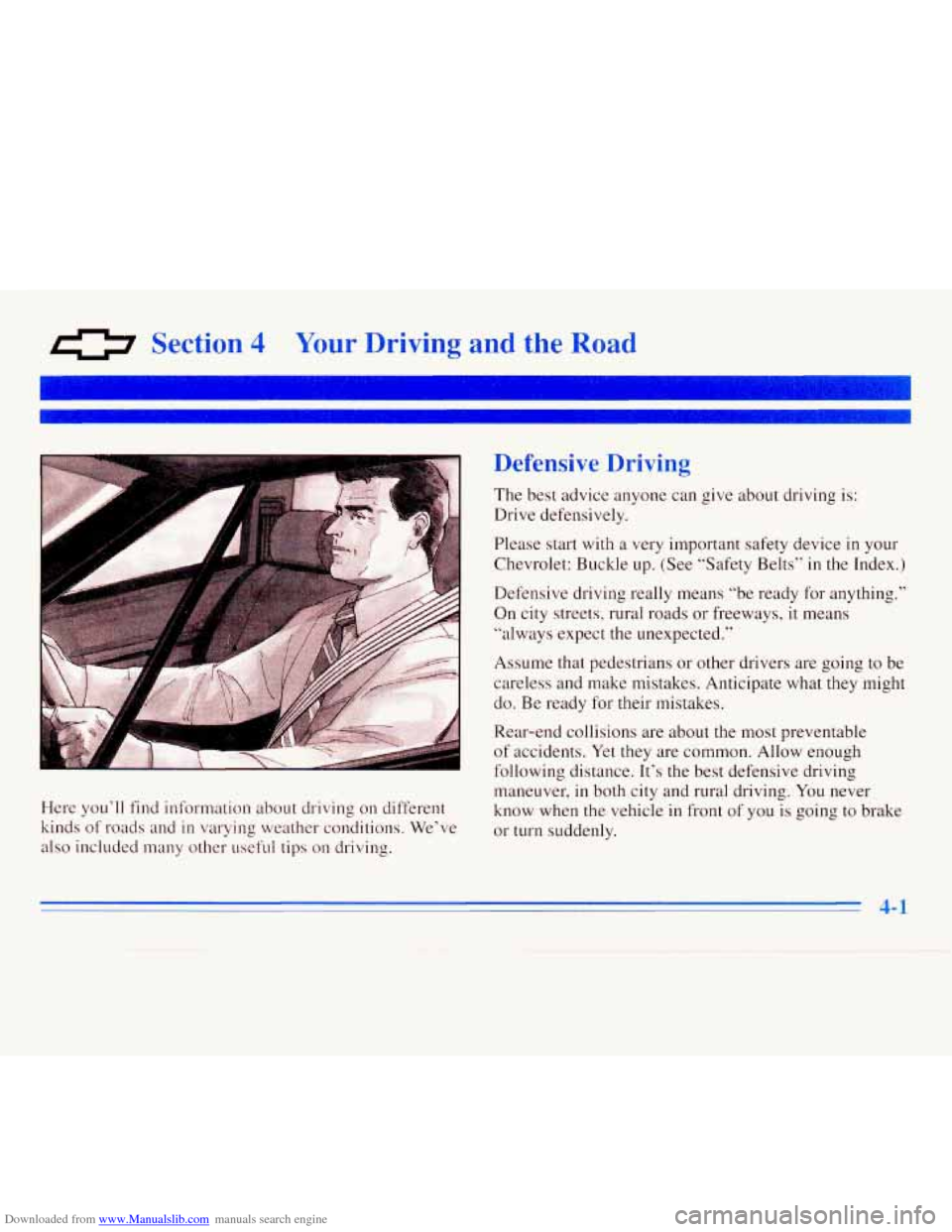
Downloaded from www.Manualslib.com manuals search engine 0 Section 4 Your Driving and the Road
Here you’ll find information about driving on different
kinds of roads and
in varying weather conditions. We’ve
also included many other useful tips on driving.
Defensive Driving
The best advice anyone can give about driving is:
Drive defensively.
Please start with
a very important safety device in your
Chevrolet: Buckle up. (See “Safety Belts”
in the Index.)
Defensive driving really means “be ready for anything.”
On city streets, rural roads or freeways,
it means
“always expect the unexpected.”
Assume that pedestrians
or other drivers are going to be
careless and make mistakes. Anticipate what they might
do.
Be ready for their mistakes.
Rear-end collisions are about the most preventable
of accidents. Yet they are common. Allow enough
following distance.
It’s the best defensive driving
maneuver, in both city and rural driving. You never
know when the vehicle in front of
you is going to brake
or turn suddenly.
Page 146 of 340
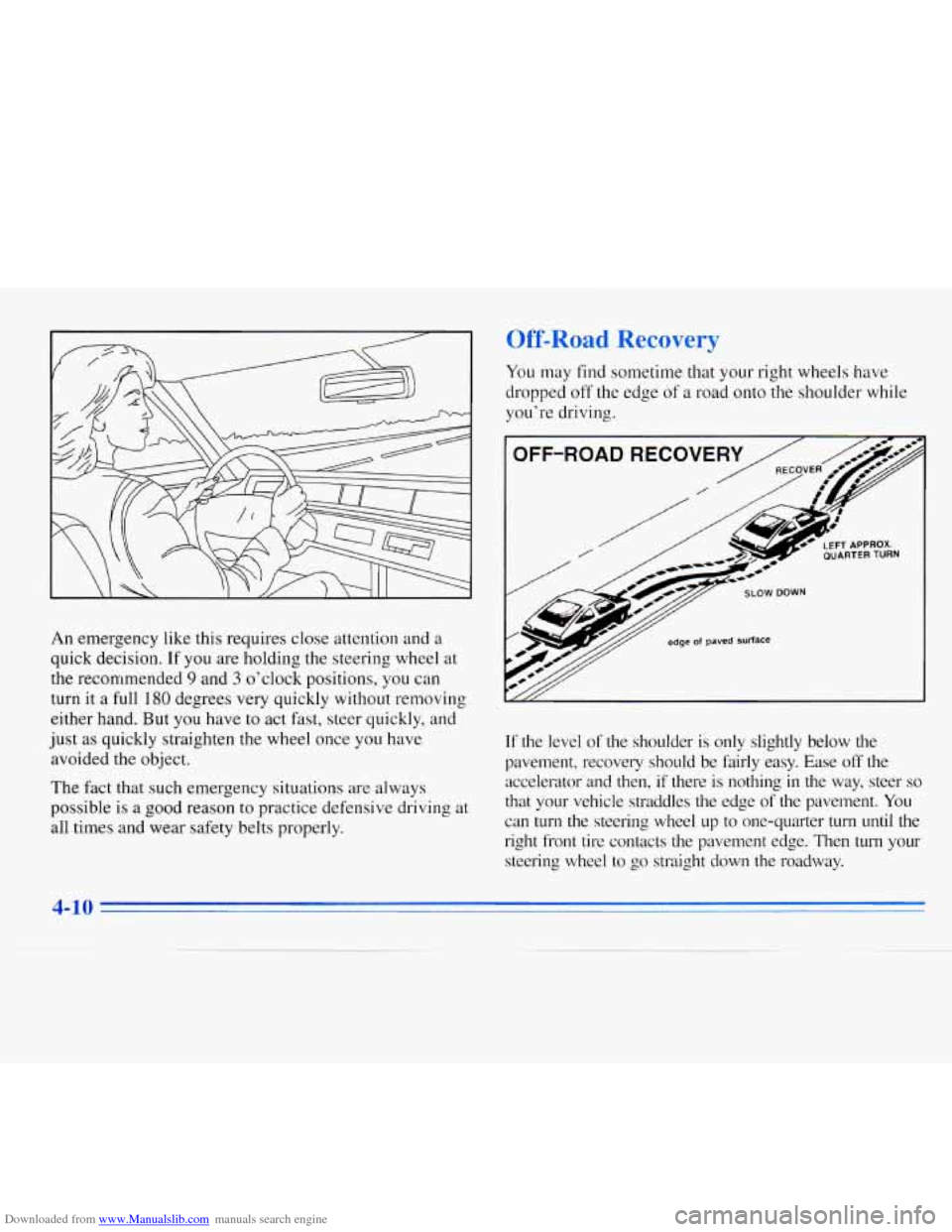
Downloaded from www.Manualslib.com manuals search engine Off-Road Recovery
An emergency like this requires close attention and a
quick decision. If you are holding the steering wheel at
the recommended
9 and 3 o’clock positions, you can
turn
it a full 180 degrees very quickly without removing
either hand. But you have to act fast, steer quickly, and
just
as quickly straighten the wheel once you have
avoided the object.
The fact that such emergency situations are always
possible
is a good reason to practice defensive driving at
all times and wear safety belts properly.
You may find sometime that your right wheels have
dropped off
the edge of a road onto the shoulder while
you’re driving.
edge of paved Surface
If the level of the shoulder is only slightly below the
pavement, recovery should be fairly easy. Ease
off the
accelerator and then,
if there is nothing in the way, steer so
that your vehicle straddles the edge of the pavement. You
can turn the steering wheel
up to one-quarter turn until the
right front tire contacts the pavement edge. Then turn your steeling wheel to go straight down the roadway.
4-10
Page 170 of 340

Downloaded from www.Manualslib.com manuals search engine Parking on Hills
You really should not park your vehicle, with a trailer
attached, on a
hill. If something goes wrong, your rig
could start to move. People can be injured, and both
your vehicle and the trailer can be damaged.
But if you ever have to park your rig on a hill, here’s
how to do
it:
1.
2.
3.
4.
5.
Apply your regular brakes, but don’t shift into
PARK (P)
yet.
Have someone place chocks under the trailer wheels.
When the wheel chocks are in place, release the
regular brakes
until the chocks absorb the load.
Reapply the regular brakes.
Then apply your parking
brake, and then shift
to PARK (P).
Release the regular brakes.
When You Are Ready to Leave After
Parking
on a Hill
1. Apply your regular brakes and hold the pedal down
while
you:
Start your engine;
Shift into a gear; and
Release the parking brake.
2. Let up on the brake pedal.
3. Drive slowly until the trailer is clear of the chocks.
4. Stop and have someone pick up and store the chocks.
Maintenance When Trailer Towing
Your vehicle will need service more often when you’re
pulling
a trailer. See the Maintenance Schedule for more
on this. Things that are especially important
in trailer
operation are automatic transaxle fluid (don’t overfill),
engine oil, belts, cooling system and brake adjustment.
Each of these is covered
in this manual, and the Index
will help you find them quickly. If you’re trailering, it’s
a good idea to review these sections before you start
your trip.
Check periodically to
see that all hitch nuts and bolts
are tight.
Page 248 of 340
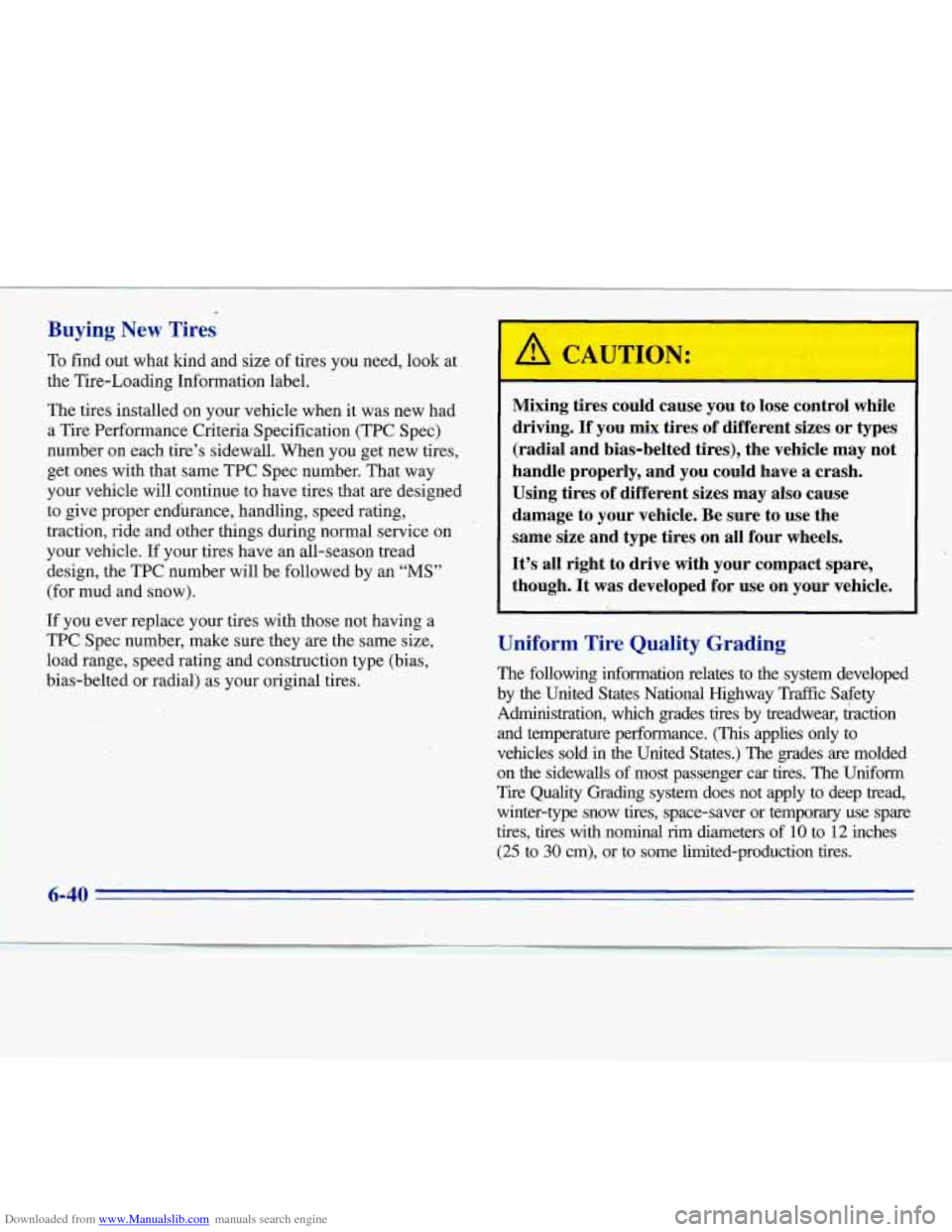
Downloaded from www.Manualslib.com manuals search engine Buying New Tires
To find out what kind and size of tires you need, look at
the Tire-Loading Information label.
The tires installed on your vehicle when
it was new had
a Tire Performance Criteria Specification (TPC Spec)
number on each ti.re’s sidewall. When
you get new tires,
~~ - -I - ~ 4
load range, speed rating and construction type (bias,
bias-belted or radial) as your original tires.
get ones
with that same
TPC Spec number. That way
your vehicle will continue to have tires that are designed
to give proper endurance, handling, speed rating,
traction, ride and other things during normal service on
your vehicle.
If your tires have an all-season tread
design, the TPC number will be followed by an
“MS”
(for mud and snow).
If you ever replace your tires with those not having a
TPC SDec number. make sure thev are the same size, Mixing tires could cause
you to lose control while
driving.
If you mix tires of different sizes or types
(radial and bias-belted tires), the vehicle may not
handle properly, and you could have a crash.
Using tires of different sizes may also cause
damage to your vehicle. Be sure to use the
same size and type tires on all four wheels.
It’s all right to drive with your compact spare,
though. It was developed for use on your vehicle.
Uniform Tire Quality Grading
The following information relates to the system developed
by the United States National Highway Traffic Safety
Administration, which grades tires by treadwear, &action
and temperature performance.
(This applies only to
vehicles sold in the United States.) The grades are molded on the sidewas
of most passenger car tires. The Uniform
Tire Quality Grading system does not apply to deep tread, winter-type snow tires, space-saver or temporary use spare
tires, tires
with nominal rim diameters of 10 to 12 inches
(25 to 30 cm), or to some limited-production tires.
Page 255 of 340
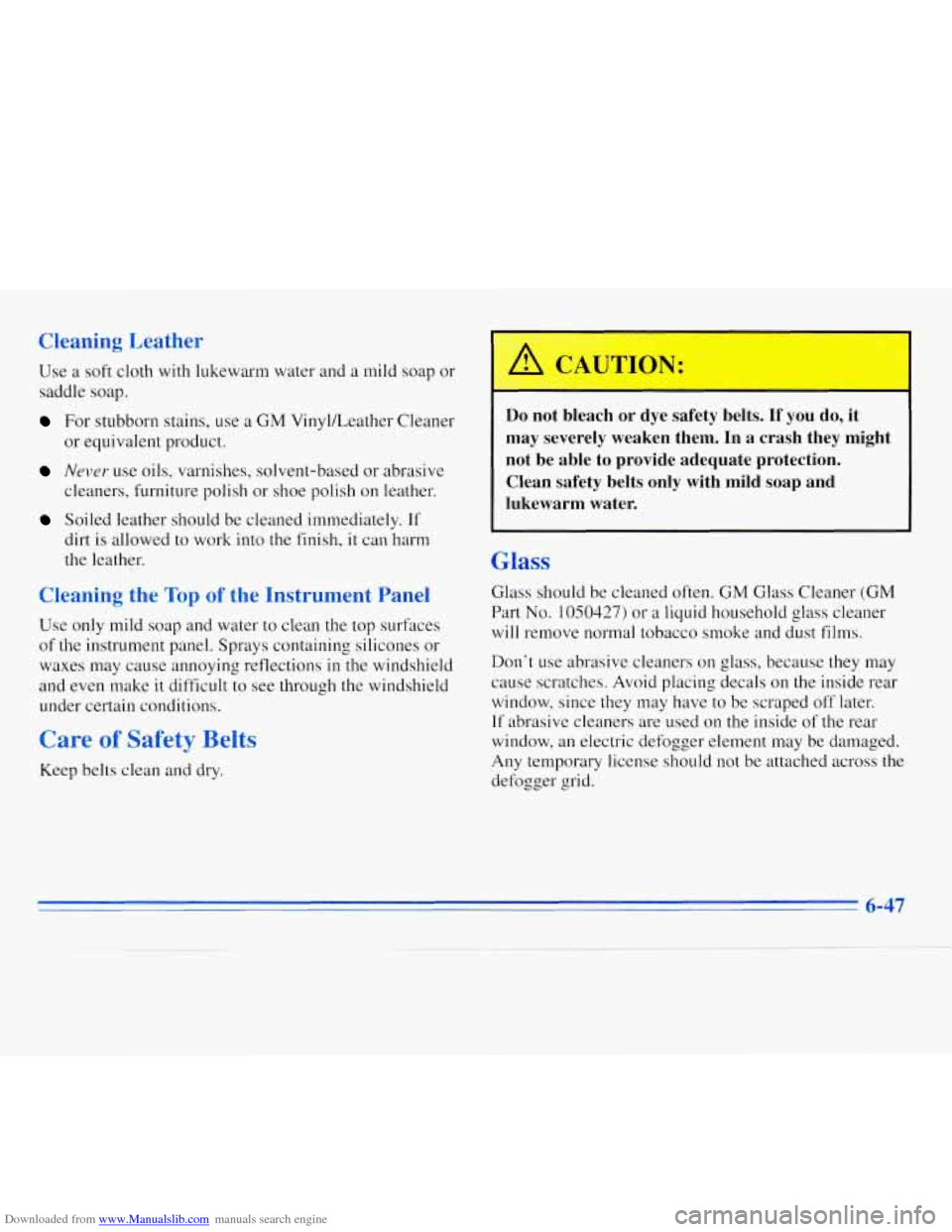
Downloaded from www.Manualslib.com manuals search engine Cleaning Leather
Use a soft cloth with lukewarm water and a mild soap or
saddle
soap.
For stubborn stains, use a GM Vinylkeather Cleaner
or equivalent product.
Never use oils, varnishes, solvent-based or abrasive
cleaners, furniture polish or shoe polish on leather.
Soiled leather should be cleaned immediately. If
dirt is allowed to work into the finish, it can harm
the leather.
Cleaning the Top of the Instrument Panel
Use only mild soap and water to clean the top surfxes
of
the instrument panel. Sprays containing silicones or
waxes may cause annoying reflections
in the windshield
and even make
it difficult to see through the windshield
under certain conditions.
Care of Safety Belts
Keep belts clean and dry.
/;1 4UTION:
Do not bleach or dye safety belts. If you do, it
may severely weaken them. In a crash they might
not be able to provide adequate protection.
Clean safety belts only with mild soap and
lukewarm water.
z
Glass
Glass should be cleaned often. GM Glass Cleaner (GM
Part No. 1050427) or a liquid household glass cleaner
will remove normal tobacco smoke and dust films.
Don’t use abrasive cleaners on glass, because
they may
cause scratches. Avoid placing decals on the inside rear
window, since they may have to be scraped off later.
If abrasive cleaners are used on the inside of the rear
window, an electric defogger element
may be damaged.
Any temporary license should not be attached across the
defogger grid.
Page 276 of 340
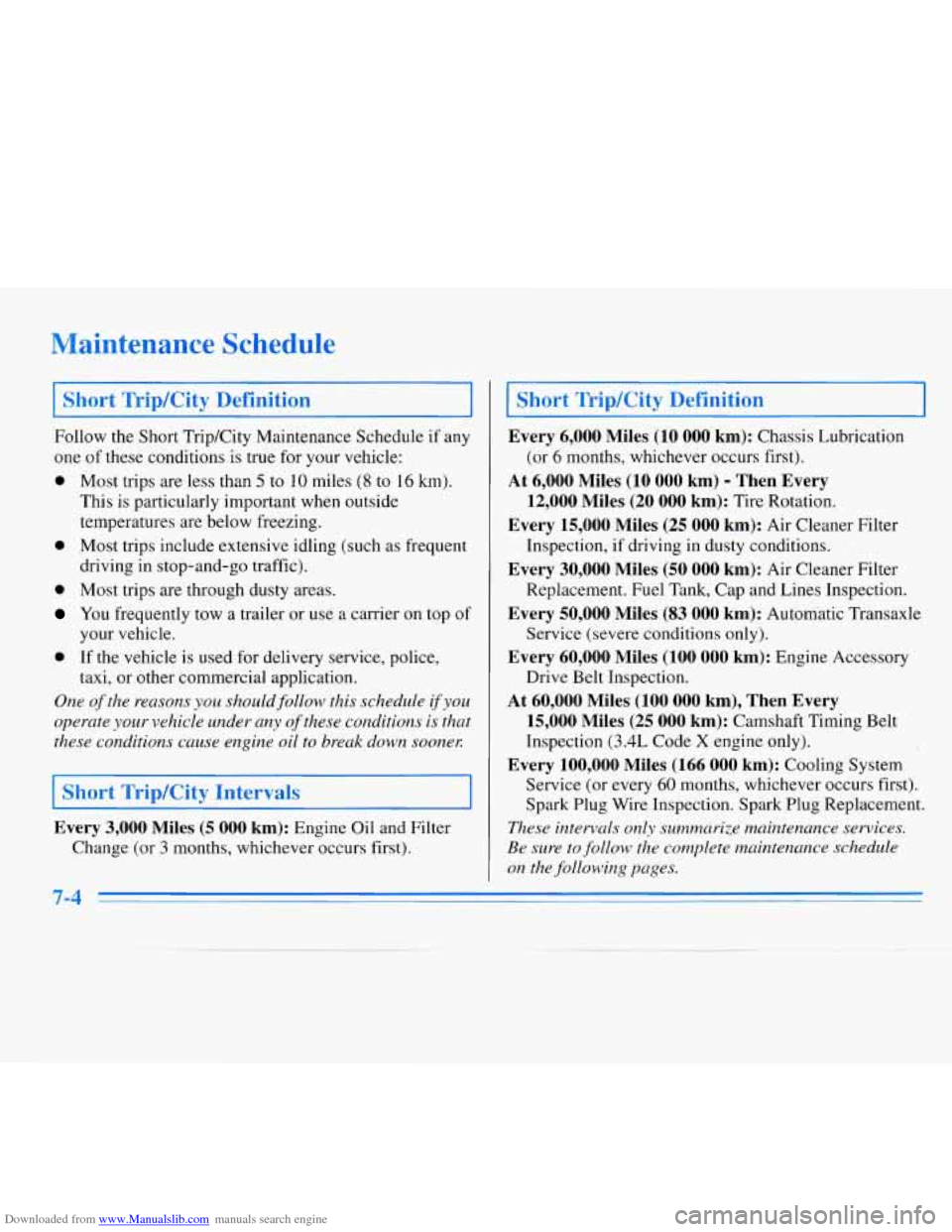
Downloaded from www.Manualslib.com manuals search engine Maintenance Schedule
I Short Trip/City Definition
Follow the Short TripKity Maintenance Schedule if any
one of these conditions is true for your vehicle:
0 Most trips are less than 5 to 10 miles (8 to 16 km).
This is particularly important when outside
temperatures are below freezing.
0 Most trips include extensive idling (such as frequent
driving in stop-and-go traffic).
0 Most trips are through dusty areas.
You frequently tow a trailer or use a carrier on top of
0 If the vehicle is used for delivery service, police,
One of the reasons you shouldjollow this schedule ifyou
operate your vehicle under any of these conditions is that
these conditions cause engine oil to break down sooney:
your vehicle.
taxi, or other commercial application.
I Short Trip/City Intervals I
Every 3,000 Miles (5 000 km): Engine Oil and Filter
Change (or
3 months, whichever occurs first).
Short Trip/City Definition
Every 6,000 Miles (10 000 km): Chassis Lubrication
(or
6 months, whichever occurs first).
At 6,000 Miles (10 000 km) - Then Every
12,000 Miles (20 000 km): Tire Rotation.
Every 15,000 Miles (25 000 km): Air Cleaner Filter
Inspection, if driving in dusty conditions.
Every 30,000 Miles (50 000 km): Air Cleaner Filter
Replacement.
Fuel Tank, Cap and Lines Inspection.
Every 50,000 Miles (83 000 km): Automatic Transaxle
Service (severe conditions only).
Every 60,000 Miles (100 000 km): Engine Accessory
Drive Belt Inspection.
At 60,000 Miles (100 000 km), Then Every
15,000 Miles (25 000 km): Camshaft Timing Belt
Inspection
(3.4L Code X engine only).
Every 100,000 Miles (166 000 km): Cooling System
Service (or every
60 months, whichever occurs first).
Spark Plug Wire Inspection. Spark Plug Replacement.
These intervnls only summarize maintenance services.
Be sure to follow the complete maintenance schedule
on the following pages.
7-4